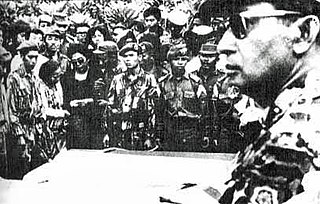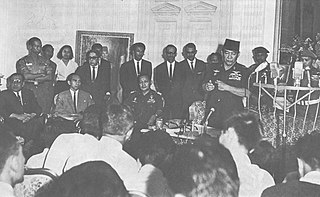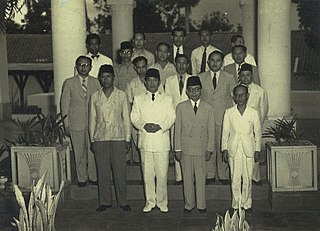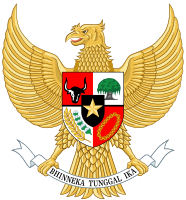
Indonesia's transition to the New Order in the mid-1960s ousted the country's first president, Sukarno, after 22 years in the position. One of the most tumultuous periods in the country's modern history, it was the commencement of Suharto's 31-year presidency.

The Order of Eleventh March, commonly referred to by its syllabic abbreviation Supersemar, was a document signed by the Indonesian President Sukarno on 11 March 1966, giving army commander Lt. Gen. Suharto authority to take whatever measures he "deemed necessary" to restore order to the chaotic situation during the Indonesian mass killings of 1965–66. The abbreviation "Supersemar" is also a play on the name of Semar, the mystic and powerful figure who commonly appears in Javanese mythology including wayang puppet shows. The invocation of Semar was presumably intended to help draw on Javanese mythology to lend support to Suharto's legitimacy during the period of the transition of authority from Sukarno to Suharto.

The Development Reform Cabinet was the Indonesian cabinet which served under President B. J. Habibie during his term as president from 23 May 1998 to 20 October 1999.

The Seventh Development Cabinet was the Indonesian cabinet which served under President Suharto and Vice President B. J. Habibie from 16 March 1998 to 21 May 1998.

The Sixth Development Cabinet was the Indonesian cabinet which served under President Suharto and Vice President Try Sutrisno from March 1993 until March 1998. The Cabinet was formed after Suharto was elected to a 6th term as President by the People's Consultative Assembly (MPR).

The Fifth Development Cabinet was the Indonesian cabinet which served under President Suharto and Vice President Sudharmono from March 1988 until March 1993. The cabinet was formed after Suharto was elected to a 5th term as president by the People's Consultative Assembly (MPR).

The Fourth Development Cabinet was the Indonesian cabinet which served under President Suharto and Vice President Umar Wirahadikusumah from March 1983 until March 1988. The cabinet was formed after Suharto was elected to a 4th term as President by the People's Consultative Assembly (MPR).

The Third Development Cabinet is the name of the cabinet of the Indonesian government led by President Suharto and Vice President Adam Malik. The cabinet was announced on 29 March 1978 and served from 31 March 1978 until 16 March 1983.

The First Development Cabinet is the name of the cabinet of the Indonesian government led by President Suharto. This cabinet was announced on 6 June 1968 and served from 10 June 1968 until 27 March 1973. The composition of this cabinet is not much different from the composition of ministers in the Revised Ampera Cabinet. Shortly after the 1971 election, on 9 September 1971, President Suharto announced a reshuffle of the First Development Cabinet and appointed the reshuffled ministers on 11 September 1971.

The Revised Ampera Cabinet was an Indonesian cabinet which served under Acting President Suharto from October 1967 until June 1968. In addition to the acting presidency, Suharto was also Minister of Defense and Security in this Cabinet.

The Ampera Cabinet was the Indonesian cabinet which served under President Sukarno and later on Acting President Suharto from July 1966 until October 1967. The cabinet was formed after the Provisional People's Consultative Assembly (MPRS) session of 1966 which commissioned Suharto to form a new cabinet. Although Sukarno would not be removed from the presidency for some months, for all intents and purposes, the person who was truly in charge of the cabinet, and Indonesia by this point, was Suharto.

The Revised Dwikora Cabinet was the Indonesian cabinet which served under President Sukarno from February 1966 to March 1966. The cabinet was formed under an extremely tense political situation, and it was expected that this cabinet would address the concerns of the people. It was during a meeting of this cabinet that unidentified troops surrounded the Presidential Palace causing to Sukarno to escape to Bogor from where he gave Supersemar to Lieutenant General Suharto.

Asisten Pribadi, better known by the acronym Aspri, were a team of advisors to Indonesian President Suharto from 1968 until 1974. The group was disbanded in the wake of the Malari incident in January 1974, though all members of the group would remain active as advisors to Suharto, including General Ali Murtopo who was appointed Minister of Information in the Third Development Cabinet in 1978.

The Soekiman Cabinet, also known as the Sukiman-Suwirjo Cabinet, was an Indonesian cabinet that served from 27 April 1951 until it fell on 23 February 1952 following revelations that it had signed a mutual security agreement with the United States, and was dissolved on 3 April 1952.

The Djuanda Cabinet, also known as the Working Cabinet, was an Indonesian cabinet that served from 9 April 1957 until 10 July 1959, when it was dissolved by a decree from President Sukarno.

The Second Working Cabinet was an Indonesian cabinet that served from 18 February 1960 until 6 March 1962, when President Sukarno reshuffled it.

The Third Working Cabinet was an Indonesian cabinet that resulted from a 6 March 1962 reshuffle of the previous cabinet by President Sukarno. It consisted of a first minister, two deputy first ministers, eight coordinating ministers, 36 ministers, as well as 13 members who headed various government bodies. It was dissolved on 13 November 1963.

The Fourth Working Cabinet was an Indonesian cabinet that resulted from regrouping of the previous cabinet by President Sukarno. It consisted of three deputy prime ministers, eight coordinating ministers, 33 ministers, six ministers of state, as well as 11 cabinet members who headed various government bodies. It was dissolved on 27 August 1964.

The Dwikora Cabinet was the 23rd Indonesian cabinet. President Sukarno reshuffled the previous cabinet on 27 August 1964 to produce a cabinet better able to implement the government policy he had announced in his Independence Day speech entitled "The Year of Living Dangerously". The cabinet was appointed on 2 September and served for a year and five months before being reshuffled on 21 February 1966.

The First Working Cabinet was an Indonesian cabinet that served from 10 July 1959 until 18 February 1960, when President Sukarno reshuffled it.


















